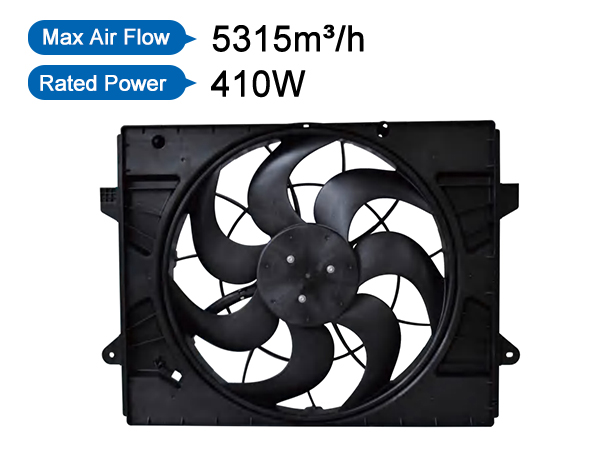The working principle of car fan - Introduce motor drive to achieve air circulation
Published:2024-07-19
The car fan is an important component of the car's cooling system, and its main function is to help the engine dissipate heat and prevent the engine from overheating. Here is a detailed explanation of the working principle of the car fan:

1. The Importance of the Cooling System
During operation, a car engine generates a large amount of heat. If this heat cannot be effectively dissipated, it can lead to engine overheating and subsequent engine damage. Therefore, the cooling system is crucial for maintaining the engine at an appropriate temperature.
2. Coolant Circulation
The car's cooling system typically uses coolant (usually a mixture of water and antifreeze) to absorb the heat generated by the engine. The coolant circulates inside the engine, absorbing heat and then flowing towards the radiator.
3. The Role of the Radiator
The radiator is located at the front of the car and contains numerous small tubes. As the coolant flows through these tubes, it releases heat to the air through the radiator's fins.
4. Working Principle of the Fan
The primary function of the car fan is to accelerate air movement to help the radiator dissipate heat from the coolant more effectively. The fan is usually located behind the radiator, and when the fan rotates, it pushes air towards the radiator, increasing the airflow speed over the radiator's surface, thereby enhancing the cooling efficiency.
5. Fan Drive Methods:
- Mechanical Drive Fan: This type of fan is directly driven by the engine's belt and is proportional to the engine's speed; the faster the engine runs, the faster the fan spins.
- Electric Fan: Modern cars often use electric fans, driven by a motor, which can operate independently of the engine's speed. Electric fans are typically controlled by a temperature sensor, which automatically activates the fan when the coolant temperature reaches a set value.
6. Temperature Control
In some modern vehicles, the activation and speed of the fan can be regulated by the Electronic Control Unit (ECU) based on the coolant temperature. This method allows for more precise control of the cooling effect and improves fuel efficiency.
7. Fan Maintenance
Regularly checking the fan's operation and cleaning the radiator is an important part of maintaining the efficiency of the cooling system. If the fan is damaged or the radiator is blocked, it will affect the cooling effect and may lead to engine overheating.
In summary, the car fan helps the radiator dissipate heat from the coolant by accelerating air movement, which is a key component in ensuring the engine operates at an appropriate temperature. With technological advancements, the application of electric fans and electronic control is becoming more widespread, enhancing the efficiency and reliability of the cooling system.
- Distribution in Water Heater Mattresses: Why BLDC Pumps Ensure Uniform Heating
- How BLDC Pumps Ensure Precise Flow in Water Dispensers
- Why BLDC Pumps Are Essential for Smart Toilets
- The Critical Role of Automotive Electronic Water Pumps in New Energy Vehicle Battery Thermal Management
- Noise Control Technology for Smart Toilet Water Pumps: Enhancing Quiet Operation in Modern Bathrooms
- Unveiling the Working Principle of Automotive Electronic Water Valves
- Comparative Analysis of Liquid-Cooled Pumps vs. Air-Cooled Systems for EV Charging Stations
- Technical Application of Brushless DC Motors in Energy Storage Circulation Pumps
- Water Heater Pump: Efficiency Upgrade for Low-Voltage Systems
- How Dishwasher Water Pumps Enhance Cleaning Coverage Through Stable Operation?
